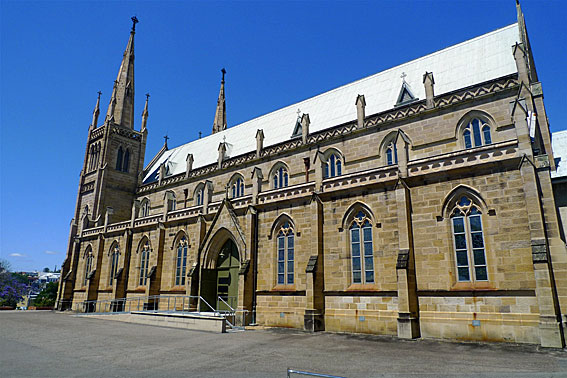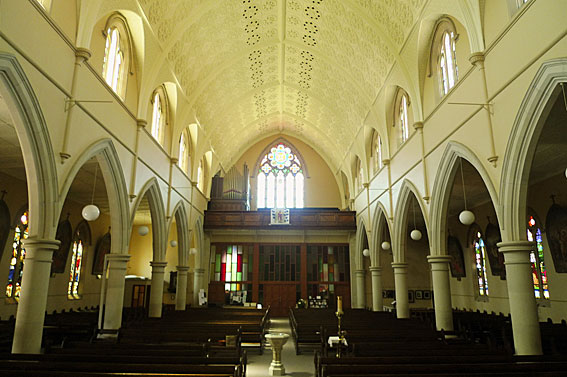
St Mary's Catholic Church, Ipswich
[Photograph by Howard Baker (October 1989)]

St Mary's Catholic Church, Ipswich
[Photograph by Howard Baker (October 1989)]
Historical and Technical Documentation by Geoffrey Cox
© OHTA 1989, 1998, 2011, 2014 (last updated October 2014)
Catholicism may be said to have reached Ipswich (then called "Limestone") with the visit in June 1843 of Bishop Polding from Sydney. The area was served initially by priests from Brisbane. A slab and shingle building on the corner of Mary and Elizabeth Streets served as the first church from around 1849, when Rev. Eugene Luckie was stationed as the priest in Ipswich. It was replaced by a new stone church on the present site in 1858-60.1

Sketch of the second St Mary's Church, built in 1858-60
[from St Mary's Story (1999), p. 6]
The foundation stone of the present St Mary's Church was laid by Archbishop Dunne on 28 October 1900, and the building was opened and dedicated by Cardinal Moran on 2 October 1904. It is built of Helidon sandstone, the design being based closely on that of the Brisbane colonial architect F.D.G. Stanley for St Joseph's Cathedral, Rockhampton. St Mary's was said at the time to be the largest Catholic church in Queensland.2

[Photograph by Trevor Bunning (November 2011)]
There were plans around December 1860 for a pipe organ 'to cost £500' in the new stone church,3 but the monies raised were used instead to acquire an American reed organ.4 There appears to have been controversy in general at the time over the appropriation of funds in relation to the purpose for which they had been raised.5

The 1915 B.B. Whitehouse & Co. organ
[Photograph by Trevor Bunning (November 2011)]
The present organ at St Mary's was built by B.B. Whitehouse & Co. of Brisbane in 1915. It was dedicated at the 11am Mass on Sunday 3 October 1915 by co-adjutor Archbishop Duhig. The description of music performed at the dedication included Mass in F by Loesch, Ave Maria by Quilmant and Laudate by Zingarelli, along with a specification of the instrument.6
The opening recital was given on the following (Monday) evening by Mr Victor Galway, who was Organist and Choirmaster at this time of St Andrew's Presbyterian Church, Creek Street, Brisbane.7 A more detailed specification and description of the instrument appeared in The Brisbane Courier two days later on 6 October:
A NEW ORGAN.
The following is the detailed specification of the new organ erected by Messrs Whitehouse and Co. in St. Mary's Church, Ipswich, as a cost of £1000, and opened by Mr. Victor Galway, Mus. Bac. on Monday evening:-Great Organ. - CC to A, 58 notes. 1. Open diapason, 8ft., metal. 2. Rohr flute, 8ft. metal. 3. Wald flute, 4ft., metal. 4. Dulciana (grooved bass), 8ft., metal. 5. Octave, 4ft., metal. 6. Harmonic piccolo, 2ft., metal. 7. Trumpet (hooded), 8ft., metal.
Swell Organ. - CC to A, 58 notes. 8. Leiblich bourdon, 16ft., wood and metal. 9. Violin diapason, 8ft., wood and metal. 10. Lieblich gedact, 8ft., wood and metal. 11. Salicional (grooved bass), 8ft., metal. 12. Voix Celeste, 8ft., metal. 13. Gemshorn 4ft., metal. 14. Fifteenth, 2ft, metal. 16. Oboe 8ft., metal. 17. Vox humana, 8ft., metal.
Pedal Organ. - CCC to F, 30 notes. 18. Bourdon, 16ft., wood. 19. Bass flute, 8ft., wood.
Couplers. - 20. Swell sub octave. 21. Swell super octave. 22. Swell to great. 23. Great to pedals. 24. Swell to pedals. 25. Pedal octave. 26. Tremulant.
Three pistons to great organ; three pistons to swell organ; balanced swell pedal.
Action. - The action is a special form of tubular pneumatic throughout, with a separate pallet to every pipe; this prevents robbing, insuring perfect speech and repetition whether the manuals are used single or doubled.
Clavier. - The keys are of the finest quality ivory, with ebony sharps.
Pedal Board. - The pedal board is of the revised Royal College of Organists (radiating and concave) is of well-seasoned walnut, dull polished.
Pistons. - The pistons are fitted with pneumatic release, the keys may be arranged by the player independently of pistons.
Soundboards. - The soundboards are of ample size, made from thoroughly seasoned timber, and painted to resist damp. Both drawstop and pallets are entirely pneumatic, the soundboards are also slideless.
Bellows. - The bellows are of ample size to insure a copious and steady supply of wind to the pipes, and are double leathered throughout, and fitted with panels, which, when removed, render every portion of the interior easy of access.
Swell Box. - The swell box is as lofty as possible, of suitable thickness, stuffed and lined inside with patent soundproof lining, and painted outside and made perfectly tight. The shutters (fitted vertically) are padded, and every precaution taken to insure effectual and silent closing.
Pipes. - The front pipes are of carefully selected stout v.m. zinc, silvered with aluminium. The interior pipes are of the best plain metal, with the trebles of spotted metal to small-scale stops, and basses of zinc of suitable thickness. The diapasons are of specially thick metal. The wood pipes are of thoroughly seasoned timber, with hardwood facings, and constructed on the most improved principle. The trebles are varnished to resist damp.
Voicing. - The voicing of the pipes is such as to secure power and accurate balance of tone in full combination, together with purity and delicacy in the soft and solo registers. The scaling of the pipes is specially adapted to the size and requirements of the building, and the work was carried out under the personal supervison of Mr. J. H. Whitehouse.8
The specification given on 6 October (above) differed from the one given on 4 October following the dedication of the organ in that it did not include the Swell Cornopean 8ft, which appears to have been added later.


[Photographs by Howard Baker (October 1989)]
Along with the instrument at St Brigid's Catholic Church, Red Hill (1914), this is one of the largest Whitehouse organs of the period, enjoying favourable acoustics in this very wide and lofty church. It is located on the liturgical South side of the rear gallery. As in other Whitehouse instruments of the period, the pipework (mostly cone-tuned in this instance) derives from A. Palmer & Son of London, and the console fittings from Thomas Harrison of London.

[Photograph by Trevor Bunning (November 2011)]
The only significant alteration to the organ since its installation appears to have been the addition of the Cornopean 8ft on the Swell, which was included in the specification published on 4 October 1915, but not in that published on 6 October (given above).9 There is evidence that the swell box has been enlarged at some stage,10 and this was presumably the 'enlargement' reportedly carried out some years after the installation of the organ by Con Hegarty, a foreman blacksmith and musician, and Cardy Wilson, a foreman toolmaker. It is possible that this occurred around 1917, when Archbishop Duhig delivered an address in which the organ was specifically mentioned.11
Whitehouse Bros undertook renovation of the organ in November 1944 at a cost of £75, and it was reconditioned by them in February 1957 at a cost of £1,200.12 Between 1987 and 1996, restoration of the organ was carried out in stages by W.J. Simon Pierce of Brisbane. This included the complete overhauling of the soundboards, cleaning and repair of pipework, new pallets, and the installation of a new blower at the side of the organ to supply adequate pressure to the action.13
It is curious that the Great Fifteenth 2ft and Swell Harmonic Piccolo 2ft appeared in the published specification of 1915 (see above) in the opposite positions from those they actually occupy.

Console of the 1915 B.B. Whitehouse & Co. organ
[Photograph by Peter Robinson (September 2014)]
| GREAT Open Diapason Dulciana Rohr Flute Octave Wald Flute Fifteenth Trumpet SWELL Lieblich Bourdon Violin Diapason Lieblich Gedact Salicional Voix Celeste Gemshorn Harmonic Piccolo Cornopean Oboe Vox Humana PEDAL Bourdon Flute COUPLERS Pedal Octave Swell to Great Swell to Pedal Great to Pedal Swell Super Octave Swell Sub Octave |
8 8 8 4 4 2 8 16 8 8 8 8 4 2 8 8 8 16 8 |
[gvd bass] [marked 8] [gvd bass] [added c.1917] |
Drawstop console (attached)
3 combination pistons to Great Organ
3 combination pistons to Swell Organ
Radiating concave pedalboard
Balanced swell pedal (brass shoe)
Swell tremulant
Compass: 58/30
Tubular-pneumatic action.14

[Photograph by Trevor Bunning (November 2011)]
__________________________________________________________________________
1 Denis W. Martin, The Foundation of the Catholic Church in Queensland (Toowoomba: Church Archivists' Society, 1988), pp. 130, 146-47; Paul Pender, 'The First Thirty Years, 1842-1872', in St Mary's Story: A History of St Mary's Catholic Parish, Ipswich, 1849-1999 (Ipswich: St Mary's Parish Historical Society, 1999), pp. 1-6.
2 Paul Pender, 'Father Horan – The Builder: 44 Years in Ipswich', in St Mary's Story: A History of St Mary's Catholic Parish, Ipswich, 1849-1999 (Ipswich: St Mary's Parish Historical Society, 1999), pp. 17-19; Queensland Heritage Council, Queensland Heritage Register, location 600577.
3 The Freeman's Journal (December 26, 1860), p. 3; The North Australian (December 14, 1860).
4 Michael Sheahan, "Music at St Mary's", in St Mary's Story: A History of St Mary's Catholic Parish, Ipswich, 1849-1999 (Ipswich: St Mary's Parish Historical Society, 1999), pp. 81-85.
5 The Courier (Brisbane,12 November 1862), p. 3.
6 Sheahan, op. cit, p. 82; Plaque on the organ; The Brisbane Courier (4 October 1915), p. 11.
7 Records of St Andrew's Presbyterian Church, Brisbane, cited by Hugh Brandon, c.1974.
8 The Brisbane Courier (6 October 1915), p. 9.
9 The Brisbane Courier (4 October 1915), p. 11.
10 Personal communication to G. Cox from Simon Pierce, September 1988.
11 Sheahan, op. cit, pp. 82, 83.
12 Whitehouse Bros Ledger (1940-1954), p. 410; Whitehouse Bros List.
13 Personal communications to G. Cox from Simon Pierce, 1988-2003; see also: Organ Society of Queensland Newsletter, vol. 17, no. 1 (August 1989), pp. 10-18; The Organ Voice, vol. 19, no. 6 (June 1992), p. 39.
14 Specification noted by G. Cox, 1973 & 1989.